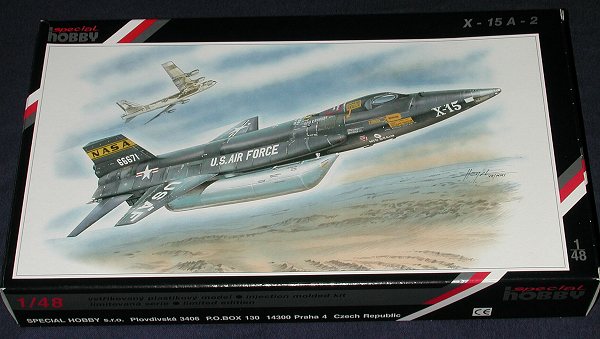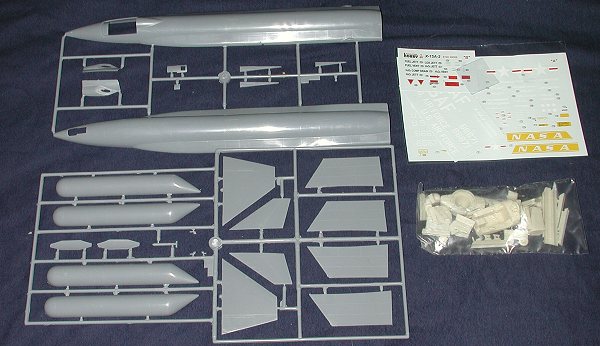
|
KIT: |
Special Hobby 1/48 X-15A-2 |
|
KIT # |
48008 |
|
PRICE: |
AUD$37.00 |
|
DECALS: |
One aircraft |
|
REVIEW & |
|
|
NOTES: |
Short run with resin parts |

|
HISTORY |
The ultimate manned research aircraft has to be the X-15. It is a plane that fired the imagination of many youth (including this one), spawned a number of astronauts, and gave high speed manned aviation research its final hoorahs.
Developed specifically to see how high and how fast a man and machine could travel in an aircraft, the first powered flight in September of 1959 with Scott Crossfield at the controls. He reached a speed of nearly 1,400 mph and an altitude of 37,000 feet on that flight. It actually was the 8th time he had been airborne in an X-15 for scheduled captive and free fall flights, but most of those ended back at base after systems failures.
Interestingly, this first powered flight was made in X-15 #2, while the last powered flight was made in October 1969 by aircraft #1. At that time it reached a height of 250,000 feet and a speed of 3,682 mph. In those ten years and 199 official flights, much was learned and much was modified on the X-15.
The ultimate version of the X-15 was the X-15A-2. This was aircraft #2 that had been damaged in an overweight landing that resulted in the aircraft landing gear collapsing and the aircraft rolling at touchdown. The NASA Pilot John McKay was injured and returned to test flying six months later, but his injuries were later the cause of his leaving NASA and test flying.
It was then decided to modify aircraft #2 by extending the fuselage to make room for more fuel and to allow it to carry external tanks for the initial boost phase up past Mach 2. Although it flew a number of flights above the design speed of Mach 6, the highest achieved speed was Mach 6.70 or 4,520 mph reached in October of 1967 with flight #188. This was with the aircraft coated in a white ablative material to protect the plane at high speed. The maximum altitude was achieved 354,000 feet on flight #91 in August of 1963. To be qualified for astronaut wings the pilot has to achieve an altitude of over 264,000 feet or 50 miles. Dozens of flights were made to that altitude and a number of X-15 pilots achieved their astronaut wings.
Only two of the three X-15s survived. During a November 1967 flight, #3 skewed sideways by overcorrection at a speed of Mach 5 while at 233,000 feet. It then entered a spin and when it reached lower levels the air pressure was enough to cause the plane to exceed maximum g loads and it disintegrated in flight, killing Air Force pilot Michael Adams. #1 is with the Smithsonian Collection and #2, the A-2, is with the USAF Collection at Wright-Patterson AFB in Ohio.
|
THE KIT |

If you have ever built a Special Hobby, MPM, Azur, Classic Airframes, LTD, or Czech Model kit, then you know exactly what to expect. All of these labels are made in the Czech Repbulic by MPM, who is a giant of the short run kits. It is thanks to MPM that we have had some rather interesting and unusual subject available to us, including this one.
When you open the box you see two large sprues, a bag crammed with resin bits and three decal sheets. Actually one of the sheets is a correction as they got the font on the major markings too thin. There is also a small square of clear acetate for you to cut out and fill in the cockpit windows. Most of us will be using something else to generate the clear bit.
You can only build the X-15A-2 with this kit as backdating it will not only require cutting a section out of the fuselage, but also replacing the landing gear and modifying the canopy, to name the most obvious alterations.
In terms of the number of parts, most of them are in resin. The main airframe and fuel tanks are in plastic and that is about it for the styrene bits. The cockpit, landing gear, ground handling trolley and other bits and pieces are all in resin so get out your dust mask and razor saw on this one. There will be a need to do a bit of hole drilling and parts cutting on this kit to do so the squeamish need not apply.
There are several options for the kit. The first is whether to add on the large external fuel tanks or not. These weren't used on all the flights so are not absolutely needed. Next is to determine if you want to display the plane on the ground or in the air. To do a ground display, you need to cut off about 2/3 of the lower fin in order for the ground handling trolley to be used. While it would have been nice to have a short lower fin provided, it wasn't and that is that. Interestingly, no rear skid actuating arms are provided, so you can't do an 'aircraft just landed' display without doing some research and extra work.
Instructions are more than adequate to build the aircraft of your choice. I highly recommend some sort of reference on the X-15 as the look of the plane changed throughout its life span. The decals are very thin and well printed. You get a number of optional markings; two for the all black version and one for the white ablative coated plane. Any of the black stripes on the external tanks will have to be painted on. A nice touch are th photos of the X-15A-2 at the USAF Museum that are printed on the back of the box. For display the plane was returned to its black paint scheme. While I'm sure the aircraft is well restored, I'd recommend period photos as often modifications made at a later date to an airframe are not removed when using a back-dated paint scheme.
|
CONCLUSIONS |
This kit will and is selling very well. I ordered mine from Australia and it was part of the second order the store owner had made to get them having sold out of the first order in record time. I'm sure it will disappear from the shelves when it gets to the US so if you want one, I'd recommend grabbing it when you first see it. NASA buffs will be especially psyched about it and though they may have preferred the earlier variant, it is much easier to backdate this kind of plane than the other way around.
|
REFERENCES |
Aerofax Datagraph #2: North American X-15/X-15A-2, 1985
If you would like your product reviewed fairly and quickly by a site that has over 100,000 visits a month, please contact me or see other details in the Note to Contributors.